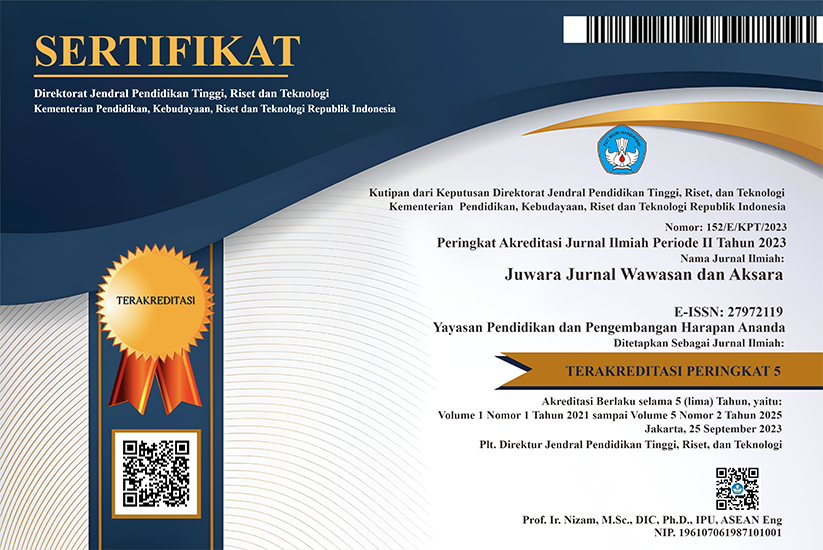Peran Kepemimpinan Visioner dalam Pengembangan Kualitas Pendidikan: Studi Kasus MTs Raudlatul Huda Cilacap
DOI:
https://doi.org/10.58740/juwara.v4i1.85Keywords:
kepemimpinan visioner, pengembangan pendidikan, madrasah tsanawiyah, peningkatan kualitas, vionary leadership, educational development, quality improvementAbstract
ABSTRAK
Kepemimpinan visioner memainkan peran yang signifikan dalam menentukan kemajuan dan kualitas lembaga pendidikan. Artikel ini mengeksplorasi peran manajemen kepemimpinan visioner dalam pengembangan Madrasah Tsanawiyah (MTs) Raudlatul Huda Cilacap sebagai studi kasus. Penelitian ini bertujuan untuk memahami bagaimana kepemimpinan visioner memengaruhi transformasi pendidikan di lembaga tersebut. Metode penelitian melibatkan observasi dan analisis data dari kegiatan pengembangan dan perubahan yang dilakukan di MTs Raudlatul Huda Cilacap. Hasil penelitian menunjukkan bahwa kepemimpinan visioner membawa dampak positif terhadap kualitas pendidikan, meningkatkan minat masyarakat, dan menciptakan lingkungan belajar yang kondusif. Studi ini memberikan wawasan tentang pentingnya kepemimpinan visioner dalam meningkatkan mutu pendidikan dan dapat menjadi referensi bagi lembaga pendidikan lainnya dalam menghadapi tantangan masa depan.
ABSTRACT
Visionary leadership plays a significant role in determining the progress and quality of educational institutions. This article explores the role of visionary leadership management in the development of Madrasah Tsanawiyah (MTs) Raudlatul Huda Cilacap as a case study. The research aims to understand how visionary leadership influences educational transformation in the institution. The research methodology involves observation and data analysis of development activities and changes implemented in MTs Raudlatul Huda Cilacap. The results indicate that visionary leadership has a positive impact on educational quality, increases community interest, and creates a conducive learning environment. This study provides insights into the importance of visionary leadership in improving education quality and can serve as a reference for other educational institutions in facing future challenges.
References
Bass, B. M. (1985). Leadership and Performance Beyond Expectations. Free Press.
Burns, J. M. (1978). Leadership. Harper & Row.
Bush, T., & Glover, D. (2014). School Leadership Models: What Do We Know? School Leadership & Management, 34(5), 553-571.
Day, C., & Sammons, P. (2016). Successful School Leadership. Education Development Trust.
Davies, B. J. (2005). The Essentials of School Leadership. SAGE Publications.
Davies, B., & Davies, B. J. (2006). Strategic Leadership. School Leadership & Management, 26(1), 29-38.
Elmore, R. F. (2000). Building a New Structure for School Leadership. Albert Shanker Institute.
Fullan, M. (2001). Leading in a Culture of Change. Jossey-Bass.
Fullan, M. (2007). The New Meaning of Educational Change. Teachers College Press.
Hallinger, P. (2003). Leading Educational Change: Reflections on the Practice of Instructional and Transformational Leadership. Cambridge Journal of Education, 33(3), 329-351.
Hallinger, P. (2011). Leadership for Learning: Lessons from 40 Years of Empirical Research. Journal of Educational Administration, 49(2), 125-142.
Harris, A., & Lambert, L. (2003). Building Leadership Capacity for School Improvement. Open University Press
Harris, A. (2008). Distributed leadership: According to the evidence. Journal of Educational Administration, 46(2), 172-188.
Harris, A. (2008). Distributed Leadership in Schools: Developing the Leaders of Tomorrow. Routledge.
Komariah, A., & Triatna, C. (2006). Visionary Leadership: Menuju Sekolah Efektif. Bumi Aksara.
Kotter, J. P. (1996). Leading Change. Harvard Business School Press.
Leithwood, K., & Riehl, C. (2003). What We Know About Successful School Leadership. Laboratory for Student Success, Temple University.
Leithwood, K., & Jantzi, D. (2005). Transformational leadership. In B. Davies (Ed.), The Essentials of School Leadership (pp. 31-43). SAGE Publications.
Nanus, B. (1992). Visionary Leadership: Creating a Compelling Sense of Direction for Your Organization. Jossey-Bass.
Pemerintah Indonesia. (2003). Undang-Undang No. 20 Tahun 2003 tentang Sistem Pendidikan Nasional.
Robinson, V. M. J., Lloyd, C. A., & Rowe, K. J. (2008). The Impact of Leadership on Student Outcomes: An Analysis of the Differential Effects of Leadership Types. Educational Administration Quarterly, 44(5), 635-674.
Robinson, V. M. J. (2011). Student-Centered Leadership. Jossey-Bass.
Senge, P. M. (2006). The Fifth Discipline: The Art & Practice of The Learning Organization. Doubleday.
Sergiovanni, T. J. (2007). Rethinking Leadership: A Collection of Articles. Corwin Press.
Spillane, J. P., Halverson, R., & Diamond, J. B. (2001). Towards a theory of leadership practice: A distributed perspective. Journal of Curriculum Studies, 36(1), 3-34.
Spillane, J. P., Halverson, R., & Diamond, J. B. (2001). Investigating School Leadership Practice: A Distributed Perspective. Educational Researcher, 30(3), 23-28.
Yukl, G. (2013). Leadership in Organizations. Pearson Education.
Downloads
Published
How to Cite
Issue
Section
License
Copyright (c) 2024 Suparyo, Muh Hanif, Suratno

This work is licensed under a Creative Commons Attribution-NonCommercial 4.0 International License.
JUWARA: Jurnal Wawasan dan Aksara provides open access to anyone so that the information and findings in these articles are useful for everyone. This journal's article content can be accessed and downloaded for free, following the creative commons license used.




















